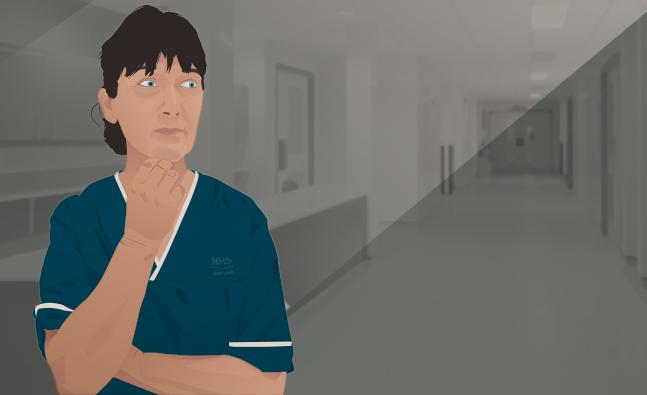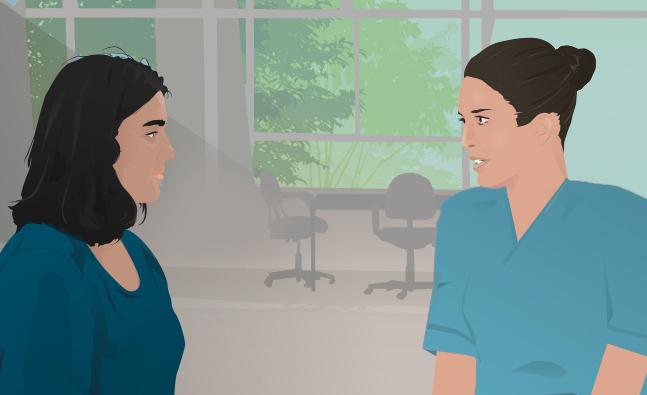STARs Module: Sensitive and effective conversations
18th e-learning module added to free STARs healthcare resource: "Sensitive and effective conversations at end-of-life care after acute stroke".
Background

The Stroke Training and Awareness Resources (STARs) website was commissioned by the Scottish Government to produce an e-learning resource which would enhance the educational opportunities for health and social care staff working with people affected by stroke. The site was developed in 2007 by the Interactive Content team (formerly LTS' e-learning department) and began as a website containing 19 Core Competencies courses for healthcare professionals. The STARs online modules have since grown into a vast e-learning resource with a further 18 Advancing Modules and 16 Thrombolysis Masterclass modules added to the website. Each modules provides an interactive way of learning with quizzes, animations, video clips and case scenarios.
Sensitive and effective conversations at end-of-life care after acute stroke
The latest training module to be created by the Interactive Content team focused on providing healthcare professionals with a toolset of communication skills that would help patients and families at a time of severe stress and uncertainty. This end-of-life care course, entitled ' Sensitive and effective conversations at end-of-life care after acute stroke', was designed to provide professionals with the competence and confidence to communicate well, even in difficult and challenging circumstances, usually have less work-related stress and greater engagement in their work.
The module was written by Professor Gillian Mead, University of Edinburgh and NHS Lothian and project managed by Fran Bailey, e-learning project manager of Chest Heart & Stroke Scotland (CHSS). Stuart Brett was the project lead for the Interactive Content team. His task as content developer was to collate Gillian's writing and with work closely with Fran in developing a suite of e-learning materials that would accurately reflect the proposed course content. Over the course of the year there were several steering group meetings held at CHSS. The meetings included invaluable input from group members selected by CHSS. Our group members included:
- Dr Fergus Doubal, University of Edinburgh and NHS Lothian
- Eileen Cowey, Researcher Nursing and Healthcare, University of Glasgow
- Professor Scott A Murray, St Columba's Hospice Chair of Primary Palliative Care, Primary Palliative Care Research Group, University of Edinburgh
- Dr Maggie Grundy, Associate Director Nursing & Midwifery, NHS Education for Scotland
- Sheena Borthwick, Service Lead, Adult Community and Rehabilitation Speech and Language Therapy Services, NHS Lothian
- Dr Kirsty Boyd, Consultant in Palliative Medicine, NHS Lothian
- Christine Lerpiniere, NHS Lothian
Developing a module that focuses on body language and communication skills
Gillian and Fran led the meetings while Stuart considered the structure and method of delivering the content. Previous modules for STARs have been relatively straight-forward for a content developer, with game-based learning materials such as multiple choice quizzes, animated simulations, visual data and 'drag & drop' games (something our team have a long history in developing), however this module relied heavily on communication skills, nuances, body language and an interpretation of difficult conversations. We decided early on that the best way to deliver the content would be to capture these situations in a real-life setting, or as real as we could achive whilst keeping each case study fictional. The group began to write detailed conversations, obstacles and solutions that depicted the sort of typical situations that they and their colleagues would encounter with patients and their families on a daily basis. Stuart's task was to transcribe each into a script and storyboard how each film would work as an interactive video that would teach the user how to effectively communicate with familes with relatives facing end-of-life care.
Zaption
We chose Zaption as the platform to host the videos. Zaption is an online platform, which provides a more engaging experience with video by including interactive elements. Zaption provided Stuart with the ability to pause a video at any point and point out a particular aspect of someone's body language, or to elaborate on an individual's thinking or possible ways to steer a discussion toward a solution that would best suit the patient and family members. After several successful video tests, we began to write bespoke scripts that accounted for these Zaption pauses. An interactive example of one of the course videos we created can be seen here.
Simulated Patient Programme
Once each module was finalised and the team were happy with the scripts, Stuart was able to begin sourcing actors who would be suitable for each fictional role. The healthcare professional roles would be portrayed by the module leads (including Prof. Gillian Meade and Fran Bailey), but for the family members we decided to work with the University’s ‘Simulated Patient Programme’. The programme supports training and assessment of medical students and professionals, with a team of dedicated volunteers featuring in many different arenas such as communication skills teaching sessions, examinations, teaching videos and online learning packages.
A Simulated Patient is someone who has been trained to portray characteristics of a real patient in order to provide an opportunity for medical students to learn about doctor - patient interactions. The Simulated Patient Programme was introduced to meet the needs of a re-structured and developed curriculum that aimed to equip students with the skills, competencies, attributes, and attitudes that would allow them to function effectively, and confidently, as a doctor following graduation. Bryan Allan, the Simulated Patient coordinator, read through each script and selected each actor and based each on the details of each role (age, gender, background).

Filming, length of shoot and location
We worked with television producer John Archer, a freelance producer, cameraman and an ex-member of LTS. John retired from the University in 2010, but has continued to work with Chest Heart and Stroke Scotland on a freelance basis. John has worked closely with my department for many years and is highly regarded amongst the staff at both CHSS and the College of Medicine and Veterinary Medicine (CMVM). John and his colleague chose to shoot the footage with two digital HD cameras positioned at two different angles, to provide some variety in the editing stages.
In order to maintain a realistic setting, we chose to film at the CMVM’s Chancellor’s Building, located within the Edinburgh Royal Infirmary. The Clinical Educator Programme (CEP) is a CPD programme of workshops and online modules in clinical education, for clinicians who teach Edinburgh University medical students. Priority is given to medics, but the programme is also open to other health professionals who teach Edinburgh medical students. Stuart has worked with Debbie and her team on previous projects and was given a tour of the ‘Virtual Ward’ – a floor within chancellors that consists of wards, beds and equipment that is used specifically for teaching students. Medical mannequins are placed in the beds, and each ward is equipped with real-life Hospital equipment, with even fake blood placed in drips. This isolated setting was perfect for filming as it meant we wouldn’t interrupt any of the medical staff within The Royal Infirmary. We created a space to resemble a small meeting room situated within a hospital and shot each case study and actor back-to-back. In total, 9 different short films were recorded in just the one day. These videos are now available as openly licenced resources on a number of popular platforms, including the University's new media asset management solution Media Hopper.
Resources
STARs Module: Sensitive and effective conversations at end-of-life care after acute stroke
Sensitive and effective conversations – videos (Media Hopper)
Sensitive and effective conversations – illustrations (Flickr)

